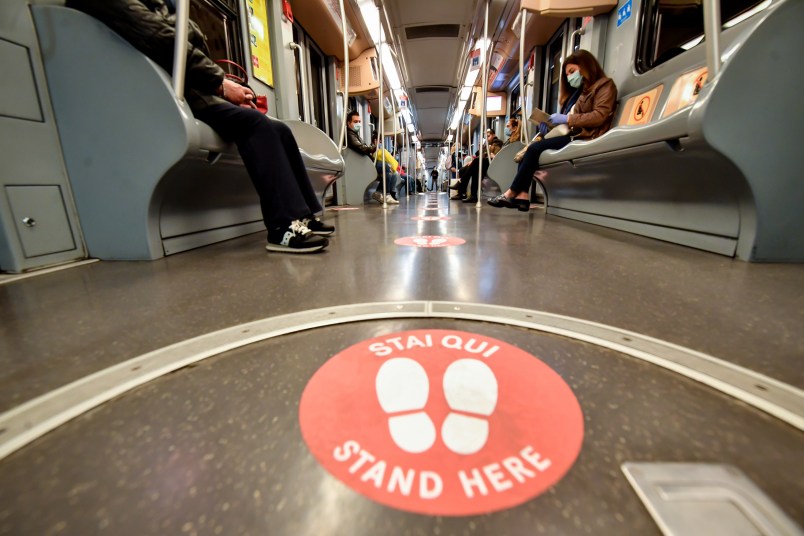THE HAGUE, Netherlands (AP) — In cities around the world, public transit systems are key to getting workers back on the job and restarting devastated economies, yet everything from trains and buses to ferries and bicycles will have to be re-imagined in the coronavirus era.
In Europe in particular, public transportation is shaping up as a new front line in the battle to tame the outbreak that has killed over 120,000 of its citizens.
In hard-hit Italy, Spain, France and Britain, standing cheek-to-jowl with fellow commuters in packed trains or trams was as much a part of the morning routine in pre-coronavirus times as a steaming shot of espresso or a crispy croissant.
That’s going to have to change as authorities try to restart their economies without losing their hard-won gains in controlling the spread of the virus.
Solutions include putting red stickers on the floor to tell bus passengers in Milan how far apart to stand. The Dutch are putting on longer, roomier trains, and many cities, including Berlin, are opening up more lanes to cyclists. In Britain, bus passengers are entering through the middle or rear doors to reduce the risk to the driver.
Announcing a gradual easing of France’s strict lockdown, Prime Minister Édouard Philippe called public transit a “key measure for the economic recovery” yet acknowledged concerns among passengers.
“I understand the apprehension of a good number of our compatriots before taking a metro, a train, a bus, a tram, which are sometimes very densely packed,” he said.
When and how to ease restrictions, keep people safe and prevent a second wave of infections is a matter of intense debate around the world.
“There will never be a perfect amount of protection,” said Josh Santarpia, a microbiology expert at the University of Nebraska Medical Center who is studying the coronavirus. “It’s a personal risk assessment. Everybody has to decide, person by person, what risk they’re willing to tolerate.”
As restrictions loosen, health authorities will be watching closely for any sign of a resurgence of the virus. Germany has reported an slight uptick in the infection rate since some small businesses were allowed to reopen over a week ago, but authorities said it was too soon to say whether the loosening was to blame.
The U.S. on Wednesday learned just how hard the crisis has hammered the world’s biggest economy as the Commerce Department estimated that the gross domestic product, the broadest gauge of the economy, shrank at an annual rate of 4.8% in the January-March quarter. That was the sharpest quarterly drop since the Great Recession in 2008-09.
The United Nations’ main labor body raised its prediction of full-time-equivalent job losses in the second quarter to an estimated 305 million.
It also projected that 1.6 billion workers in the “informal economy,” including those working without proper contracts or oversight by government regulation, “stand in immediate danger of having their livelihoods destroyed.” That is nearly half the global workforce of 3.3 billion people.
In Paris, aircraft maker Airbus reported a first-quarter loss of 481 million euros ($515 million), laid off t housands of workers and sought billions in loans to pull through the crisis.
Ratings agency Fitch cut Italy’s government debt rating — the first downgrade to a major economy — in a reflection of the damage done by the lockdowns. The agency lowered the country one notch to BBB-, just one level above junk bond status. It expects the outbreak to shrink the Italian economy by 8% this year.
Germany’s economy minister said the government is projecting a 6.3% drop in GDP this year but a sharp recovery in 2021.
France, Spain and Greece were the latest countries to announce roadmaps for reopening businesses and schools. They promised to spread people out on trains, trams and buses, and face masks will be the new normal in public.
The Dutch national railway began bringing longer trains back into service to make it easier for passengers to stay apart.
The capacity of Milan’s metro system will be slashed to just 350,000 passengers a day, compared with 1.3 million on normal workdays. Mayor Giuseppe Sala is calling for staggered working hours and more working from home to help deal with the cutbacks.
Around the world, confirmed infections stood at more than 3.1 million — including 1 million in the U.S. — and the confirmed global death toll topped 217,000, according to a tally by Johns Hopkins University. The true toll is believed to be much higher because of limited testing, differences in counting the dead and concealment by some governments.
With South Koreans about to celebrate their longest holiday since infections there surged in February, authorities urged people to think twice about traveling and to continue to wear masks, not share food and stay home if they are feeling sick.
“We must not let a moment of carelessness trigger mass transmissions that would make the efforts we invested so far vanish like bubbles of water,” Vice Health Minister Kim Gang-lip said.
In China, where the virus first emerged late last year, the government announced that its ceremonial parliament will be held late next month after its original meeting was postponed. The convening of the full session will involve 3,000 members.
In Japan, officials asked people not to travel during the country’s upcoming Golden Week holiday.
___
Associated Press journalists around the world contributed to this report.
___
Follow AP pandemic coverage at http://apnews.com/VirusOutbreak and https://apnews.com/UnderstandingtheOutbreak







The next big hurdle will be controlling the second outbreak.
All of these measures would be assisted by workplaces that allowed staggered arrival times for workers.
What about those who already stagger into work?
The next big hurdle will be Donnie covering up the second outbreak, and / or blaming it on anybody but Donnie.
FIFY
Hey bud. Would you lay off the cruel attacks on our valued SOROS INTERNATIONAL Group team members, please?